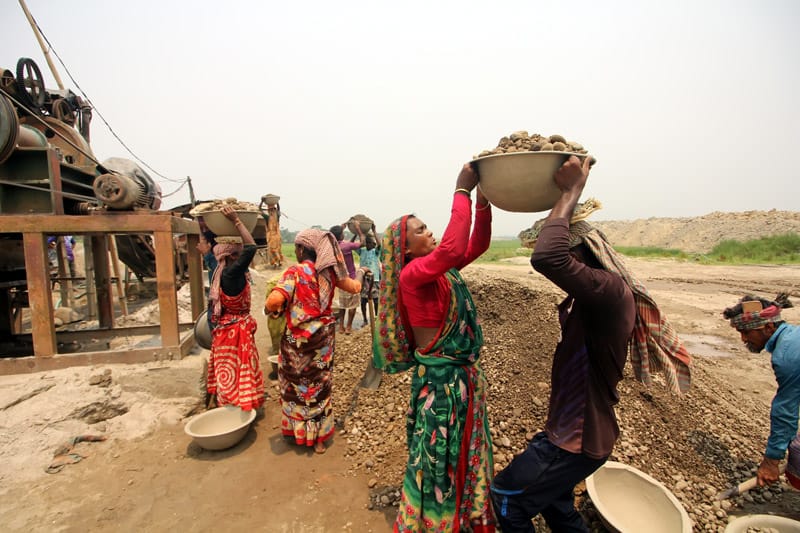Women make up an estimated 30% to 50% of the global workforce in artisanal and small-scale mining (ASM). That number rises to 70% or higher in places like Guinea or Uganda. Supporting women must thus be central to any effort to transform ASM for the broader betterment of workers, communities, and the environment.
Nonetheless, long-standing structural barriers continue to prevent women from fully participating in ASM. Women in the workforce tend to work without any employment status or records. This is often due to customs, traditions, or legal restrictions that prevent them from owning or inheriting land and mineral rights. They also overwhelmingly find themselves in peripheral roles doing things like washing and sorting ore, transporting materials, or preparing food. Compared to the digging roles mostly held by men, these jobs are poorly compensated and at a higher risk of becoming obsolete from new technologies.
Far from being a remedy, formalization campaigns can reinforce gender-based inequity in the ASM sector.
Women also face structural barriers to accessing financing, technologies, and equipment. This leaves them using rudimentary equipment that can reduce their safety, productivity, and the overall benefits they receive from their work.
In addition, the money laundering and other illicit financial transactions that accompany many ASM operations contribute to an environment that is especially unsafe for women and jeopardizes their safety, with an increased prevalence of gender-based violence and human trafficking.
Many decision-makers point to ASM formalization as the answer. But such efforts are commonly built with requirements that many women are not able to fulfill due to disparities in resources, information, education, and technology. Far from being a remedy, formalization campaigns can reinforce gender-based inequity in the sector.
While we can be sure that half of the ASM workforce is especially vulnerable and faces continued exclusion, poverty, and insecurity, it is important to note that women do benefit economically and socially from ASM work. It provides them with essential household income and, in many cases, social status in return for their valuable labour.
Women’s Rights Key to a Sustainable ASM Sector
First of all, supporting women to realize their potential by fully participating and earning fair incomes for their contributions to the ASM sector will help us create a better ASM sector that is fair and equitable.
Looking at the bigger picture, closing the gender pay and productivity gaps, eradicating gender-based violence, and upskilling women miners can help communities solve broader challenges, such as food insecurity, educational gaps, and poverty. For instance, many studies have shown that women tend to spend their incomes on family nutrition and educating their children. Therefore, investing in women is investing in our future.
Importantly, women have the fundamental human right to equal opportunities and access to social and economic benefits in the workforce. This right is enshrined in many international treaties that states are obliged to uphold.
Women in ASM Urgently Need a Safety Net
How can governments take action? An urgent priority is to ensure women in ASM can access health care and critical services, including emergency financial aid and gender-based violence support services. The pandemic underlined these shortcomings by intensifying gender inequalities.
In Zimbabwe, for example, mining was deemed essential work during the pandemic but the same designation was not applied to ASM service providers, which includes most of the female workers in the sector. As a result, woman-headed households in ASM communities reported skipping more meals than those headed by men. In Peru, half of the women miners were already living in extreme poverty, with 75% earning less than the minimum wage. But during COVID-19 lockdowns, 80% of these women were not eligible for government aid due to their unregistered status.
Upskilling So Women Can Realize Their Potential
There is also a pressing need for public and industry-backed skills development programs that consider the needs and limitations of women in ASM and are tailored to train them to contribute to the evolving mining sector. For instance, investing in digital skills for women can go a long way to increasing incomes and resilience to economic disruptions. For women to benefit from such endeavours, the programs must benefit workers with and without formal education and provide a living income and childcare support for attendees.
Targeted Support to Help Overcome Obstacles
Governments can act by establishing accessible women-centred mentoring and counselling services—of critical importance for women in remote communities. Such programs can make a material difference to vulnerable workers, for instance, by helping women get licensed and providing access to things like legal support, equipment, and business services.
Allocate Mining Revenue to Invest
Governments should re-invest tax and royalty revenue to fund these policies and programs. In some cases, they may opt to incentivize mining operators to contribute as part of their environmental, social, and governance commitments.
The Way Forward Is Clear
Any effort to make ASM more economically, socially, and environmentally sustainable must address the acute challenges facing women in the sector. Without things like closing the gender pay and productivity gaps, eradicating gender-based violence, and providing upskilling opportunities for women, there can be no true progress in ASM. Decision-makers in government and industry must use their power and resources to invest in women and reshape ASM for the betterment of ASM communities around the globe.
The preceding was originally published on Mexico Business News and is republished here with permission.

